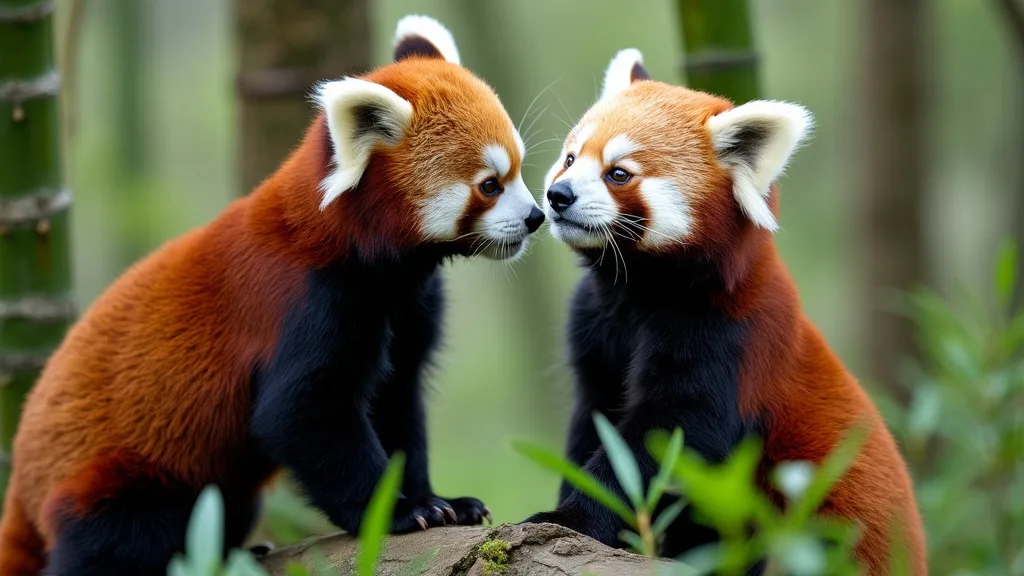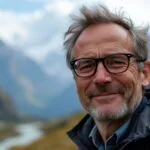Red pandas have a seasonal mating cycle, with breeding occurring between January and March to ensure that cubs are born in summer, when food is most abundant. Their reproductive timing is influenced by daylight changes, temperature shifts, and food availability, ensuring that young are raised during optimal environmental conditions
During mating season, red pandas—usually solitary animals—become temporarily social, engaging in scent-marking and vocalizations to attract mates. Females are receptive for only 1-2 days, making precise timing critical for reproduction. Once mating occurs, males play no role in cub-rearing, and females raise their young alone, providing constant care in tree hollows or rock dens
Gestation lasts about 134 days, but red pandas experience delayed implantation, meaning the embryo does not immediately attach to the uterus. This adaptation synchronizes birth timing with summer food availability, increasing cub survival rates
This article explores the timing of red panda mating season, their courtship behaviors, and the challenges they face in the wild due to habitat loss
Timing and Environmental Factors of Red Panda Mating

Red pandas follow a strictly seasonal breeding cycle, with mating occurring between January and March. This timing is not random; it aligns with environmental conditions that maximize cub survival. By ensuring that mating takes place in late winter, red pandas give birth in early summer (June–July), when bamboo shoots and young leaves are at their peak nutritional value. Since bamboo constitutes the primary food source for red pandas, particularly for lactating mothers, the synchronization between breeding and food abundance plays a critical role in reproductive success
The red panda’s reproductive cycle is influenced by seasonal cues such as temperature shifts, photoperiodism (changes in daylight hours), and food availability. As winter progresses, the gradual increase in daylight hours triggers hormonal changes in both males and females, preparing them for mating season. This biological adaptation ensures that cubs are born during a season of plenty, allowing mothers to provide adequate nutrition and care without the additional stress of food scarcity
Why Red Pandas Mate Between January and March
Red pandas do not reproduce randomly throughout the year but instead follow a precisely timed reproductive pattern that aligns with seasonal conditions. Mating occurs in late winter, from January to March, ensuring that cubs are born in June or July. This strategy is essential for cub survival, as summer is the period when bamboo shoots and young leaves emerge, providing the highest protein and moisture levels necessary for lactation and cub development
Studies conducted at the Toronto Zoo confirm that environmental conditions play a major role in reproductive timing. The increase in daylight hours after the winter solstice triggers hormonal activity, leading to the onset of mating behaviors. This biological mechanism, known as photoperiodism, is a key regulator of fertility cycles in many seasonal breeders
Temperature also plays a significant role in mating season intensity. Observations from the Nashville Zoo (2022) suggest that red pandas living at higher elevations or colder climates display more pronounced reproductive behaviors compared to those in warmer regions, where breeding activity may be less intense. This suggests that cooler temperatures reinforce hormonal shifts, making late winter the optimal breeding period for red pandas in the wild
The Role of Temperature and Daylight in Reproductive Cycles
Environmental factors such as temperature and light exposure influence red pandas’ reproductive readiness. Unlike animals that breed opportunistically, red pandas have a strictly seasonal reproductive cycle, dictated by hormonal responses to environmental cues. As daylight increases in late winter, hormonal changes stimulate mating behaviors and fertility in both males and females
Studies from the Louisville Zoo confirm that photoperiodism plays a direct role in regulating fertility, ensuring that reproduction occurs only when conditions are optimal for cub survival. In captive settings, where artificial lighting and controlled temperatures are present, some red pandas may breed outside their typical season, reinforcing the idea that natural environmental cues dictate their reproductive timing in the wild
Temperature also affects reproductive success, as colder months trigger mating readiness while ensuring that cubs are born in a milder season. If mating occurred in warmer months, cubs would be born in harsh winter conditions, leading to higher mortality rates. The seasonal synchronization of temperature, light, and food cycles is essential for ensuring successful births and healthy cub development
How Delayed Implantation Ensures Cubs Are Born in Summer
Red pandas possess a unique reproductive adaptation known as delayed implantation, which helps synchronize births with optimal environmental conditions. Although the gestation period lasts about 134 days, the fertilized embryo does not immediately implant in the uterus. Instead, it remains in a dormant state for a period before implantation occurs. This biological delay ensures that cubs are born at the right time of year, when food availability is highest
This reproductive strategy is vital for red panda survival, as it allows the mother’s body to time the pregnancy according to external environmental factors. Without delayed implantation, cubs might be born too early, before bamboo shoots and leaves reach their highest nutritional value. This could compromise the mother’s ability to produce sufficient milk, putting the cubs at risk of malnutrition and lower survival rates
The process of delayed implantation also provides physiological advantages, giving the female red panda more time to prepare a den before birth. Since red pandas give birth in tree hollows, rock crevices, or dense vegetation, they require adequate time to construct a secure environment for their cubs. This ensures that newborns, which are blind and helpless at birth, have a safe and warm space to develop during their first few months
By aligning birth timing with peak food availability and favorable climate conditions, red pandas increase their chances of reproductive success. This strategy highlights the delicate balance between environmental factors and survival, making the conservation of their natural habitat essential for sustaining healthy breeding populations in the wild
For further details on how environmental factors influence red panda reproduction, visit the Louisville Zoo’s page on red panda mating behavior
Mating Behavior and Courtship Rituals

During mating season, red pandas exhibit distinct behavioral changes that help them locate and attract potential mates. Although they are solitary animals for most of the year, they become temporarily social during January to March, engaging in scent-marking, vocalizations, and physical interactions to facilitate reproduction
Males become more territorial and active, while females exhibit short-lived receptivity, making the timing of mating critical for reproductive success. Understanding these courtship rituals provides insight into how red pandas communicate, form temporary bonds, and navigate their seasonal reproductive cycle
How Male and Female Red Pandas Interact During Breeding Season
Unlike many social species, red pandas do not form long-term pair bonds. Instead, males and females interact only briefly during mating season, after which they return to solitary living. During this period, males become highly mobile, traveling greater distances within their home range to locate receptive females
When a male encounters a female in estrus, chasing and playful interactions often precede mating. The female may initially exhibit avoidance behaviors, but if she is receptive, she allows the male to approach. Mating typically occurs on the ground, where the male mounts the female in a short but intense interaction (Toronto Zoo). Once mating is complete, there is no further bonding between the pair, and the male moves on to seek other mating opportunities
Females, on the other hand, have an extremely narrow window of fertility, remaining receptive for only 24 to 48 hours. This short timeframe makes precise timing essential, as missing this window means the female will not conceive for another year. Because of this, red pandas have evolved highly efficient mating behaviors, ensuring that successful fertilization occurs within one or two mating attempts
The Importance of Scent-Marking in Red Panda Courtship
Scent-marking plays a key role in red panda mating behavior, serving as the primary means of communication between potential mates. Both males and females use their anal glands, urine, and foot glands to mark trees, rocks, and pathways, leaving chemical signals that indicate their reproductive status
Males rely heavily on scent detection to locate females in estrus. As they move through the forest, they frequently sniff-marked areas to assess the presence and fertility state of nearby females. If a female is receptive, her scent markings become stronger and more frequent, signaling that she is ready to mate
Females, in turn, assess the scent intensity and frequency of male markings to determine potential mates. More dominant or genetically fit males tend to mark more frequently, making their scent easier to detect. This passive selection process allows females to choose mates based on territory size, scent strength, and persistence
Observations from the Nashville Zoo (2022) suggest that scent-marking intensity increases dramatically during the breeding season, with males marking up to four times more frequently than in non-reproductive months. This surge in marking behavior helps maximize reproductive opportunities, ensuring that females can be located within their brief fertility window
How Brief Female Receptivity Affects Mating Success
One of the most unique aspects of red panda reproduction is the short duration of female receptivity. Unlike many mammals that remain fertile for extended periods, red panda females experience estrus for only one to two days per year. This means that successful mating depends on perfect timing, efficient mate detection, and rapid courtship behaviors
Because of this short fertility window, males become highly active and aggressive in seeking mates, increasing their territorial patrols and scent-marking intensity. They must locate a receptive female quickly, as missing this opportunity means waiting an entire year for another chance to reproduce
Females, while briefly receptive, are selective in their choice of mates. If an approaching male is not perceived as strong or genetically fit, she may reject his advances, waiting for a higher-quality mate. This selective behavior ensures that only the most adaptable and resourceful males contribute to the gene pool, reinforcing species survival in the wild (Louisville Zoo)
Once mating occurs, the female’s focus shifts entirely to pregnancy and cub-rearing, with no further interaction between the sexes. Males do not play a role in cub-rearing or den preparation, and females must navigate pregnancy, birth, and lactation alone
For more insights into red panda courtship behaviors, visit the Nashville Zoo’s article on red panda reproduction
Birth, Cub Rearing, and Conservation Challenges

After a successful mating season, female red pandas enter a unique reproductive phase that includes delayed implantation, extended gestation, and intensive cub care. Unlike many mammals, red panda mothers raise their young completely alone, providing nourishment, warmth, and protection for the first few months of life. However, habitat loss and environmental disruptions pose significant challenges to their reproductive success, making conservation efforts essential for ensuring healthy wild populations
Why Red Panda Cubs Are Born in Summer
Red panda cubs are born in early summer (June–July), a timing that aligns with peak bamboo growth, ensuring that mothers have access to high-nutrient food sources. Because lactation requires substantial energy, having an abundant food supply during this period significantly increases cub survival rates
Studies from the Toronto Zoo highlight that bamboo shoots and young leaves, which contain higher protein and moisture levels, emerge precisely when red panda cubs are born. This synchronization is not accidental—it is a result of delayed implantation, an adaptation that allows females to control the timing of cub birth based on environmental factors. By ensuring that births coincide with optimal food availability, red pandas maximize maternal health and cub development
Another reason for summer births is temperature regulation. Newborn red pandas are blind, immobile, and highly vulnerable to cold temperatures. If cubs were born in late winter or early spring, they would face increased risks of hypothermia, reducing their chances of survival. The milder temperatures of summer create a safer environment, allowing cubs to develop in a stable and warm setting inside their dens
The Role of Female Red Pandas in Raising Cubs
Unlike many other mammal species, male red pandas play no role in cub-rearing, leaving all parental duties to the mother. Immediately after mating, males and females separate, and the female takes full responsibility for preparing the den, giving birth, and nursing her offspring
In the weeks leading up to birth, the female searches for a safe, enclosed space to build her nest. She typically chooses tree hollows, rock crevices, or dense vegetation, where she gathers leaves, moss, and soft plant materials to create a warm and well-insulated den. The den serves as a protective environment, shielding the cubs from predators and extreme weather conditions
Newborn red panda cubs are blind and deaf, weighing only about 3 to 5 ounces (90–130 grams) at birth (Louisville Zoo). They remain completely dependent on their mother for warmth and nutrition, feeding exclusively on her milk for the first 8–12 weeks. The mother rarely leaves the den during this period, venturing out only for short feeding sessions before returning to tend to her cubs
As the cubs grow, the mother gradually introduces solid foods, typically starting with soft bamboo shoots. By four months of age, cubs begin exploring outside the den, learning climbing and foraging skills under their mother’s supervision. Despite this early independence, cubs remain with their mother for up to a year, learning survival behaviors before fully dispersing to establish their own territories
How Habitat Loss and Conservation Efforts Impact Reproduction
One of the biggest threats to red panda reproduction is habitat destruction, which disrupts breeding patterns and cub survival. The expansion of agriculture, logging, and human settlements has significantly reduced the availability of safe nesting sites and nutrient-rich bamboo forests, making it harder for females to successfully raise their young
In degraded habitats, red panda mothers may struggle to find secure den locations, leading to higher cub mortality rates. Additionally, the loss of bamboo forests means that food scarcity becomes a greater challenge, particularly for lactating mothers who require a consistent supply of high-nutrient bamboo shoots to sustain milk production
To counteract these threats, conservation programs focus on habitat protection, sustainable forestry practices, and breeding initiatives to ensure stable red panda populations. Organizations like the Red Panda Network and WWF work to restore bamboo forests, establish protected wildlife corridors, and implement anti-poaching laws to safeguard red pandas in the wild
Captive breeding programs also play a vital role in maintaining genetic diversity and supporting population recovery. Zoos and conservation centers worldwide, including the Toronto Zoo, Nashville Zoo, and Louisville Zoo, participate in global breeding efforts that help prevent inbreeding and increase overall red panda numbers. These initiatives contribute to species survival, ensuring that red pandas continue to thrive both in the wild and in managed care environments
For more information on conservation programs supporting red panda reproduction, visit the Toronto Zoo’s page on red panda breeding













